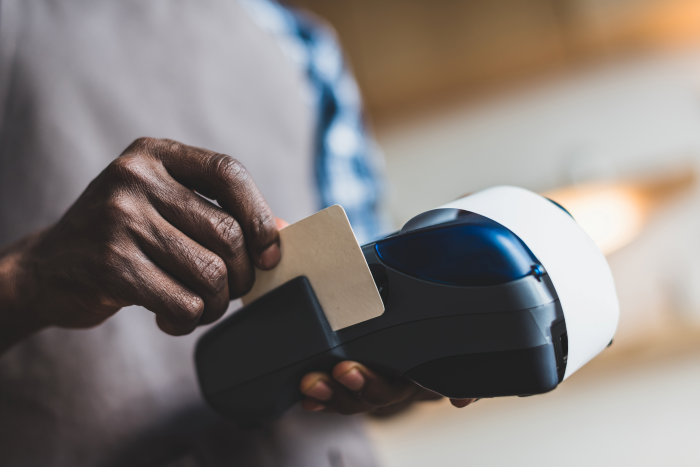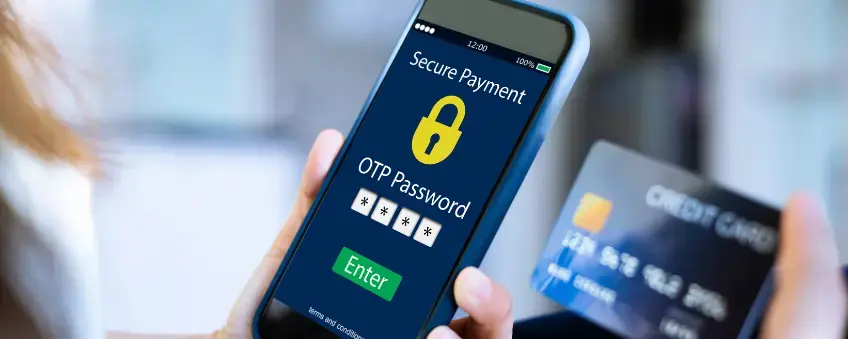Accepting credit cards from customers no longer requires a bulky POS system with extensive hardware. Businesses can now process payments on the go with a range of mobile card readers, including ones compatible with iPhone, Android, and other mobile devices. While mobile card readers gained popularity with on-the-go businesses, such as food trucks and market stall operators, many brick-and-mortar businesses also utilize these compact payment tools. And with just 9% of American consumers using cash for payments, card readers are becoming an unavoidable necessity
Fortunately, modern businesses are spoiled for choice when it comes to mobile card readers. This guide explores the top credit card readers for iPhone and Android. We'll also overview how mobile card readers work, provide tips for choosing the best mobile card reader provider, and explore other related topics. Read ahead if your business is ready to find a card reader for iPhone and Android.
How to Choose the Best Mobile Credit Card Reader for Your Business
Choosing the best card reader for Android and iPhone will help you and your staff members benefit from a payment system tailor-made to your needs. Below, let's explore some tips to keep in mind when choosing a card reader for iPhone and Android:
Consider Industry-Specific Features
Industry-specific features make life easier for businesses with unique requirements. Many mobile card readers come with POS software designed for mobile phones and tablets. For example, if you operate a restaurant business with table service options, it's worth finding a mobile card reader that makes it easy to split checks and update orders on the go.
Assess Payment Flexibility
Be sure to explore the various payment options available from your mobile card reader. In some instances, a mobile card reader will be attached to a specific payment processor, making it impossible to source your own merchant account. However, some mobile card readers are compatible with third-party payment providers, making it possible to shop around for superior rates and features.
Avoid Long-Term Commitments
With new payment technology arising routinely, it's critical your business can take advantage of changes in the credit card processing landscape. If your business signs a long-term contract with a mobile card reader provider, you may find yourself stuck with outdated technology, high processing fees, and other disadvantages. Fortunately, there are many top mobile card readers that are accessible without long-term commitments.
Explore High-Risk Mobile Card Reader Options
If your business operates in a high-risk industry—such as CBD, adult entertainment, or subscription services—it may face challenges in obtaining mobile credit card readers. Many payment processors steer clear of high-risk merchants. However, specialized high-risk merchant service providers exist to assist these industries in accessing top-tier payment solutions. Partnering with such providers can offer valuable insights into the best mobile card readers suited to your business needs.
Read Customer Reviews
Evaluating customer feedback is crucial before settling on a mobile card reader. Effective marketing does not always equate to reliable performance. Consulting consumer watchdogs like the Better Business Bureau can help verify the credibility of a card reader's claims. Consistent issues with a provider are likely to affect you similarly.
Top Credit Card Readers for iPhone and Android
The market is filled with mobile credit card reader options for small businesses across the United States. In the following section, we'll delve into the top credit card readers available for iPhone and Android users.
Clover Go: Best Overall Mobile Card Reader
Clover is a cloud-based POS platform offering a range of point-of-sale and payment processing solutions to US businesses. The company has over a decade of experience building and distributing POS technology to its clients. With the Clover Go mobile card reader, merchants benefit from a compact, sleek mobile card reader with a range of payment method options. There's also a Clover Go mount available to merchants wanting to fix their Clover Go card reader on a countertop.
There are two plans available for Clover Go merchants.
First, the Clover Payments plan. It's free and offers basic access to the Clover Go platform. However, your business must still pay commissions on any processed payments (as well as a $49 upfront fee for the mobile card reader hardware).
Second is the Clover Essentials plan, which costs $14.95 per month and offers extra features, such as inventory management, staff management, and more. Both plans come with Clover Go's virtual terminal, simplifying the process of taking card-not-present transactions.
However, some Clover contracts require merchants to sign long-term agreements. While it's possible to end the contract prematurely, it will result in the merchant paying the remaining subscription fees before being able to switch to a new mobile card reader provider. In-house payment processing costs are the same on both plans:
- In-person Transactions: 2.6% + 10¢
- Keyed-in Transactions: 3.5% + 10¢
Key Features
Wide Range of Payment Methods
Clover Go offers access to tap, chip, and swipe payments, making it simple to accept all types of credit cards (and mobile device payments such as Apple Pay).
Bookkeeping Integrations
Clover Go integrates with leading bookkeeping platforms, such as QuickBooks and Xero. This integration functionality makes it simple to reconcile accounts and track revenue figures.
24/7 Customer Service
Clover is always available to answer customer requests 24/7. If you run a business operating outside normal business hours, such as a bar, this is an extremely useful feature.
Extensive Reporting (For Essentials Plan)
For merchants paying $14.95 per month for the Essentials plan, there's access to extensive reporting, including tax reporting, real-time sales tracking, detailed sales reports, and more.
Business Management Features (For Essentials Plan)
In addition to reporting, the Essentials plan offers a range of business management features not always found in mobile card reader products. There are extensive inventory management tools. It's easy to track inventory, edit inventory, add new products, and more. Likewise, merchants can offer discounts, track customer purchases to a specific customer ID, manage shifts, provide individual logins and permissions to staff members, and more!
Pros
- Compatible with both iPhone and Android
- Payment flexibility
- Affordable hardware
- Custom configurations
- Highly functional app
Cons
- Lengthy contracts
- Not suitable for low-volume merchants
- Restricted third-party payment options
Shopify: Perfect for eCommerce Businesses
Shopify continues to be one of the world's most influential eCommerce platforms. The company made a name for itself by simplifying the process of setting up an eCommerce business and selling products online. Merchants benefit from an easy-to-use web builder, third-party apps, and an integrated payment system. And now, Shopify offers in-person payment processing options, including a mobile card reader.
Merchants can download the Shopify POS to their iOS or Android devices and integrate the mobile card reader using Bluetooth. The app makes it simple to split bills across multiple payments, track inventory, and send receipts. Likewise, it's possible to integrate your online Shopify store with a brick-and-mortar location, simplifying data tracking across all sales channels.
Previously, Shopify required an eCommerce plan to use this mobile card reader. This is no longer the case—you can now access Shopify in-person payments by choosing either the Shopify Starter plan or the Shopify Retail plan (both plans are specifically geared for in-person payments).
However, unlike many of the other mobile card readers on our list, Shopify allows flexibility in terms of payment processing. Shopify mobile card reader merchants can choose between using Shopify Payments and third-party payment processors, but there will be a small commission fee if you choose to use a third-party payment provider (this fee is lower if you choose a higher Shopify subscription tier).
For merchants choosing to use Shopify Payments, the processing costs are as follows:
- Shopify Starter: $5 per month, and 5% + 30¢ for in-person transactions
- Shopify Retail: $105 per month, and 2.7% for in-person transactions
Key Features
Omnichannel Sales
Shopify makes cross-channel sales accessible for businesses of any size. If you already have a Shopify eCommerce store, you can combine it with the Shopify POS system to offer omnichannel payments to your customers.
Simple Integration with Shopify
If you already use Shopify for online sales, the Shopify mobile card reader's seamless integration is unparalleled.
Inventory Management Tools
Shopify makes it simple to upload and track inventory, easing the burden on management of both online and brick-and-mortar inventory.
Easy-to-Use App
As with its eCommerce web-building platform, Shopify has prioritized ease of use with the Shopify POS app. Simply download it on your mobile device and begin navigating to your merchant dashboard to view transactions, manage inventory, track customer payment history, and more.
24/7 Customer Support
Shopify offers around-the-clock customer support, ensuring merchants are never left without a payment expert to contact if issues with their mobile card reader arise. If your business operates outside normal business hours, this is a much-needed benefit.
Pros
-
Easy to Integrate
-
Payment flexibility
- No long-term contracts
- Easy-to-use mobile app
- Low per-transaction processing costs for the Shopify Retail Plan
Cons
- Fewer features than other leading providers
- Must pay a monthly subscription to access affordable processing fees
- Shopify charges fees if you use a third-party payment processor.
QuickBooks GoPayment: Makes Accounting Simple
QuickBooks is a world-famous accounting software seeking to streamline business accounting for business owners of all sizes. The QuickBooks GoPayment card reader is an in-person credit card processing device built to facilitate convenient payments and integrate with QuickBooks software and services. If you already use QuickBooks to manage your business's accounting, then QuickBooks GoPayment is an easy way to integrate all your reporting and analytic requirements.
However, QuickBooks GoPayment isn't making waves in the industry purely because of its connection to QuickBooks accounting software. The company has produced a high-quality hardware product with extensive battery life and a unique power stand. The card reader sits on top of a cylinder-shaped power stand, which is perfect for countertop use. When the card reader is removed, it lasts without its power stand for up to one week, making it exceptionally versatile for on-the-go businesses.
QuickBooks GoPayment users have a range of options when it comes to purchasing the service. The basic plan is free; merchants only pay for processing fees. But there are also other plans that provide additional features, such as bookkeeping and accounting, at a monthly fee (in addition to processing fees). Let's explore pricing below:
- QuickBooks Money: $0 per month + 2.99% per card transaction
- QuickBooks Simple Start: $30 per month + 2.99% per card transaction
- QuickBooks Essential: $60 per month + 2.99% per card transaction
- QuickBooks Plus: $90 per month + 2.99% per card transaction
QuickBooks often offers introductory promotions, so make sure to check the latest offers if you want to save on the monthly subscriptions.
Key Features
Integration with QuickBooks Software
The QuickBooks GoPayment mobile card reader is built specifically to integrate with QuickBooks' various software platforms. If you already use QuickBooks to manage accounting, bookkeeping, and other elements of your business, this integration is a powerful resource.
Long-Lasting Battery Life
The QuickBooks GoPayment card reader lasts up to a week without charging, making it one of the longest-lasting hardware products on the market. It also fits seamlessly onto its charging base — it's super convenient for countertop ordering!
All Payment Methods Available
As with most card readers on our list, QuickBooks GoPayment ensures your customers can use all their favorite payment methods, including PIN, contactless, and more. Likewise, all major card brands are accepted.
Affordable Pricing for Small Value Products and Services
As QuickBooks only charges a percentage of each transaction (instead of a fixed fee + percentage), it's a solid choice for businesses selling low-ticket items.
Pros
- One of the longest-lasting batteries on the market
- Excellent countertop-mounted charger
- Sleek design
- Integrated with QuickBooks Accounting and Bookkeeping Software
- Advanced analytics
Cons
- Some monthly subscriptions are expensive
- Payment processing fees are high for high-value items (2.99%)
- Built specifically for QuickBooks Users
Square: Best Compact Mobile Card Reader
Square is synonymous with mobile card readers. The company's "square" card readers, which attach to auxiliary and lightening cable ports, revolutionized the way mobile businesses accepted payments. While Square now offers a range of payment tools, including card terminals and large-scale POS systems, its compact mobile card readers are still a massive hit with many business owners.
Backing up Square's tiny card reader devices is a powerful app with a range of industry-specific tools. This is a popular card reader platform for both retail and restaurant businesses. Simply download the Square app to your iPhone or Android device to begin accepting payments with your Square card reader. However, you must purchase two separate card readers if you want both magstripe and chip payments (there isn't a card reader that accepts both simultaneously).
Currently, Square will send you a free card reader with no commitment requirements. The company's basic payment processing services don't come with any monthly subscription fees. Fees are as follows:
- In-Person Payments: 2.6% + 10 cents per transaction
Key Features
Extremely Compact Design
Square's card readers are likely the most compact on the market—we certainly haven't seen anything smaller!
No Monthly Fees
With no monthly fees and free card readers available to merchants, Square is a good option for small or new businesses with a limited budget.
Industry-Specific Tools
Square's software has industry-specific tools to make it easier for staff members to process payments, accept returns, split tabs, and more.
Range of Additional Hardware and Software Options
While Square's mobile card reader and app are all you need to accept mobile payments on an iPhone, there are more hardware options available as well. Product scanners, POS systems, cash drawers, payment terminals, and more are all available. Square can scale as your business's needs evolve.
Pros
- Sleek, compact design
- Affordable processing rates
- Extensive hardware and software options
- Excellent for restaurants and retail
- Free card reader for US businesses
Cons
- Not known for strong customer support
- Card readers don't offer magstripe and PIN on same device (must obtain two card readers)
Payanywhere: Best "Basic" Mobile Card Reader
Payanywhere is a payment processing company providing a range of in-person and online payment services, including card readers and POS systems. The Payanywhere mobile card reader is a 3-in-1 payment system offering chip, swipe, and contactless payments. Its compact design fits easily in your pocket, but it's also suitable for countertop payment processing.
Payanywhere doesn't charge monthly fees—merchants are only responsible for processing fees. However, if your business does not process payments for 12 months, Payanywhere will administer a $3.99 monthly inactivity fee until you resume payments. Processing rates are as follows:
- In-Person Payments: 2.69% per transaction
- Payments Keyed into Virtual Terminal: 3.49% + $0.19
High-volume businesses can also negotiate custom payment rates.
Key Features
3-in-1 Payment System
Payanywhere's mobile card reader features a 3-in-1 payment system, allowing for chip, contactless, and swipe payments via a single device.
Industry-Specific Tools
Payanywhere lists industry-specific tools for the following niches:
- Medical Services
- Automotive
- Stores & Boutiques
- Health & Beauty
- Quick Serve & Bars
Integrates with Virtual Terminal Software
Payanywhere has a virtual terminal software designed for accepting card-not-present payments. By coupling Payanywhere's mobile card reader with its powerful virtual terminal, businesses can offer a range of payment options to customers, improving overall convenience.
Pros
- Compact design
- Affordable processing rates
- All payment methods available
- Coupled with an excellent virtual terminal
- Suitable for countertop and tableside payments
- A range of industry-specific tools
Cons
- Extensive Payanywhere branding on the card reader
- Basic app compared to some competitors
PayPal Zettle: Perfect for Existing PayPal Users
Like some of the other mobile card reader providers on our list, such as Shopify, PayPal made its name in the digital sphere. PayPal's primary products include digital wallets, peer-to-peer money transfers, digital invoices, and other online tools. But in September 2018, PayPal acquired iZettle, a POS provider, for $2.2 billion dollar. The move marked a concerted effort by PayPal to enter the in-person payment sphere, which has now resulted in the PayPal Zettle — a mobile card reader.
With the mobile card reader from PayPal Zettle, iPhone and Android users can wirelessly connect a compact card reader to their phones. Next, by downloading the PayPal Zettle app, merchants can access a range of POS tools and integrations with other PayPal services. Likewise, PayPal Zettle has recently introduced a new product allowing merchants to accept contactless payments directly via their phones (with no external card reader). While this is a revolutionary way to accept payments, it doesn't include the benefits of chip and pin payments (for which you need the traditional PayPal Zettle card reader). Below, check out the PayPal Zettle processing rates:
- In-Person Payments: 2.29% + $0.09 per transaction
- Manually Input Payments: 3.49% + $0.09 per transactions
Key Features
Integrates with PayPal's Other Payment Systems
PayPal offers a range of payment services, including payment gateways, digital wallets, online consumer loans, and more. If you already use PayPal for other payment services, PayPal Zettle makes it easy to integrate a mobile card reader into your payment stack.
Accepts All Major Card Brands and Payment Types (Aside from Swipe)
PayPal Zettle accepts all major card brands. Merchants also have access to chip payments and contactless payments. However, PayPal no longer allows "swipe" payments, as this is considered a less secure payment method.
Extensive Integration Options
PayPal Zettle understands the value of integrating with third-party systems. Merchants can integrate the PayPal Zettle platform with QuickBooks, BigCommerce, WooCommerce, and more!
Pros
- Backed by PayPal—one of the world's most recognized payment brands
- Affordable hardware and processing costs
- No long-term commitments
- Eight hours of battery life
Cons
- PayPal has reports of freezing funds without warning
- No swipe payment option on the card reader
- Simple design
Helcim: Extended Battery Life
Helcim is a mobile card reader provider and payment processor offering standard hardware with affordable processing fees. Helcim's card reader connects to smartphones via Bluetooth and allows for chip payments and contactless payments. It's easy to set up email receipts, inventory tracking, and other backend features. Likewise, merchants can store customer card details for future use.
Where Helcim differentiates from the crowd is its pricing structure. Helcim offers interchange-plus pricing, so prices will vary depending on card brand and other factors. This means there isn't a set price for payment processing, but interchange-plus pricing is often much better value than flat-rate pricing. Helcim claims its average in-person payment processing fee for mobile card readers is 1.94% + $0.08.
Key Features
All-Day Battery Life
Helcim's card reader is basic, but this ensures its battery lasts all day long. There's no need to keep this hardware plugged into a charger.
Multiple Color Choices
Helcim offers a range of color options for the countertop base (which holds the card reader). This gives merchants various aesthetic customization options to fit branding.
Keep Cards on File
Helcim allows merchants to keep customer cards on file, making future transactions seamless for both customers and merchants.
Interchange Plus Pricing
Unlike many of the card reader providers on our list, Helcim offers interchange-plus pricing. This means the processing fees merchants pay are much more reflective of the actual cost of each transaction (this is usually cheaper than flat-rate pricing).
Pros
- Long-lasting battery
- Affordable payment pricing
- Reliable card reader for basic needs
Cons
- Simple Card Reader
- More complex payment fee structure
SumUp: Excellent for Sales Analytics
SumUp is a POS provider and payment processor with two mobile card reader options for US merchants. Fortunately, SumUp doesn't charge any monthly fees to access their card readers or payment processing services. Just pay for the hardware upfront, and SumUp charges commissions on the transactions you process.
Merchants benefit from an easy-to-use dashboard, counter-mounting options, and a host of other benefits. Still, while SumUp offers plenty of functionality to its merchants, neither of its card readers offers anything substantially different from other options on our list. One of the key differentiators with SumUp is its payment processing pricing—there's no fixed fee element in its pricing, meaning your business only pays a percentage of each transaction. This makes it a strong option for businesses selling low-cost goods or services. Below, explore the basic payment processing costs available from SumUp:
- 2.75% for any in-person transaction
Key Features
Two Grades of Mobile Card Reader
At SumUp, there are two types of card readers: the SumUp Plus and the SumUp Solo. The SumUp Plus is a compact, basic card reader priced at $39. It offers all the basic payment features required to accept credit cards and contactless payments. However, if you want a more advanced portable card reader, the SumUp Solo (priced at $129) has a touchscreen, so there's no need to connect it to a phone to gain access to full payment features.
Functional Dashboard for Computers and Mobile Devices
SumUp offers its merchants access to a full dashboard, which is available for mobile devices and desktop access. Merchants can log into the dashboard to view a wide range of reporting information, including sales data and other useful analytics.
Integration with a SumUp Business Bank Account
SumUp offers merchants access to business bank accounts. If you want to connect your business's payment platform to a business bank account, SumUp makes the process seamless with its in-house banking services.
Pros
- Suitable for small transactions
- No long-term contracts
- Functional card readers
- Access to business banking
Cons
- Not as advanced as some competitors
- No access to full merchant account
Understanding Mobile Credit Card Readers
You can think of mobile card readers as pocket-sized digital cashiers. They're like miniaturized versions of the traditional checkout counter you'd find in a store, but they connect directly to your smartphone or tablet. These devices transform your mobile device into a secure, on-the-go payment processor.
Here's how it works: When you want to make a purchase with your credit or debit card, the mobile card reader connects to your mobile device through Bluetooth or a physical attachment. Then, like a translator, it communicates with your bank to ensure the funds are available and securely transfers them to your merchant account.
They empowers individuals and small businesses to accept payments wherever they go, whether at a craft fair, a food truck, or a garage sale.
These versatile tools offer convenience and flexibility. They don't require a traditional cash register or bulky hardware, making them perfect for businesses on the move or those with limited space. With the rise of contactless and chip card payments, these little marvels simplify transactions, keeping your money safe and accessible wherever you are.
How Do Mobile Card Readers Work?
Mobile card readers use a range of technological tools to process credit card transactions. Let's explore the three primary mobile card reading methods below:
NFC Technology
NFC (Near Field Communication) technology is growing in popularity as many businesses and industries turn toward contactless payments. It enables secure, contactless transactions between devices, like smartphones and payment terminals, by bringing them close together. Benefits include speed, convenience, and enhanced security as card data remains encrypted and doesn't need to be physically swiped or inserted, reducing the risk of data theft.
The use of NFC in the United States was accelerated rapidly by the COVID-19 pandemic — the desire to reduce contact with others and third-party objects made contactless payments much more attractive. Research suggests that between 2020 and 2030, the NFC chips market may achieve a compounded annual growth rate (CAGR) of 8.49%.
EMV Chip
EMV chips are now commonplace in the payment sphere. By the end of 2021, there were 12 billion EMV chips in circulation across the globe. EMV chips are embedded microchips on credit and debit cards, enhancing payment security. For consumers, EMV chips offer protection against card cloning and fraud, as they generate a unique transaction code for each purchase, making it extremely difficult for criminals to replicate. This reduces the risk of unauthorized charges and boosts confidence in card usage.
Businesses benefit from EMV technology by reducing liability for fraudulent transactions. If they have EMV-compliant terminals and the customer uses an EMV chip card, liability shifts to the card issuer in some cases of fraud. EMV adoption also aligns with global payment standards, ensuring compatibility and reducing the risk of payment processing issues when operating internationally. Overall, EMV chips enhance security and reduce financial risks for both consumers and businesses.
Magstripe
Magnetic stripe payments, also known as magstripe payments, involve the use of a magnetic stripe on the back of credit or debit cards to store account information. The benefits of magstripe payments include simplicity and wide acceptance, as magstripe readers are prevalent globally.
However, they have notable disadvantages. First, magstripes are vulnerable to data breaches, as the information on the stripe is static and can be easily copied or skimmed. This makes magstripe cards more susceptible to fraud compared to chip or contactless technology. Secondly, magstripe technology is becoming outdated, with many countries transitioning to more secure EMV chip cards and contactless payments. Finally, they require physical contact with card readers, which is less convenient compared to contactless NFC payments, which only require a tap or wave, making magstripe payments less user-friendly.
Advantages of Using Mobile Card Readers
Mobile credit card readers offer a range of benefits to businesses. Let's explore the top advantages of using this type of payment hardware:
Operate Without a Brick-and-Mortar Location
Previously, operating a business without a brick-and-mortar location made it challenging to accept credit card payments. Traditional credit card processing platforms require POS systems, Wi-Fi, and other infrastructure, making it difficult to offer payment flexibility on the go. However, with mobile credit card readers, mobile businesses can offer payment processing to customers anywhere they have access to a mobile network.
Bring Payments to Your Customers
While mobile card readers are often utilized by businesses without a fixed location, they also offer benefits to traditional enterprises with brick-and-mortar storefronts. With mobile card readers, your staff can bring convenient payments directly to your customers, ensuring shoppers don't need to check out at a central POS location. For example, shoppers can purchase products from a staff member on the store floor, or restaurant waiters can accept payment from customers directly at their table.
Use Existing Hardware
When you use a mobile card reader compatible with iPhones or Android phones, you can use your existing phone to process payments. There's no need to spend $1000s on new POS systems and card readers!
Access Advanced Apps
Many mobile credit card reader providers have mobile apps with extensive payment features. For example, your mobile card reader may be attached to a POS app, making it simple to process orders, split tabs, accept payments, process tips, and more!
In addition to the in-house apps provided by many mobile card reader providers, integration options are often available. Third-party app integrations allow merchants to benefit from a range of additional features, such as stock tracking, accounting management, loyalty programs, and more.
Accepting Mobile Payments Without a Card Reader
A mobile credit card reader is the most convenient and efficient tool for accepting credit card payments on the go, but there are alternatives. Mobile virtual terminals make it simple to input a customer's credit card details without a physical card reader. Let's explore this unique payment tool in more detail below.
Mobile Virtual Terminal
A mobile virtual terminal makes it simple to accept card-not-present transactions without a computer. A traditional, computer-based virtual terminal allows a merchant to input a customer's credit card details to process over-the-phone orders, email orders, and other card-not-present transactions. A mobile virtual terminal serves this same purpose. Merchants can use their mobile phones to input credit card details and accept payments from customers without a physical card. This is a popular payment tool for businesses that accept customer orders in advance, such as caterers or flower shops.
Final Thoughts on Mobile Card Readers
Given the vast array of options in the market, consulting with a merchant service provider can be immensely beneficial. Many merchant service providers, including high-risk merchant account providers, offer dedicated support to clients seeking new payment solutions. Leveraging a payment expert's knowledge of payment hardware and software can help your business get the best card reader for your specific needs.






